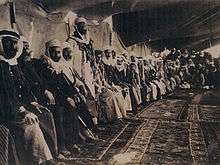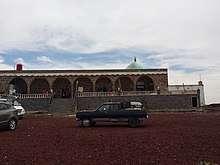Druze people in Syria
The Druze community of Syria is believed to constitute an estimated 3.2 percent of the population (as of 2010),[3] or approximately 700,000 persons (including residents of the Golan Heights).[1][4] The Druze are concentrated in the rural, mountainous areas east and south of Damascus in the area known officially as the Jabal al-Druze.[5] The Druze faith is a monotheistic and Abrahamic religion - Druze are not generally considered Muslims.[6][7]
| Total population | |
|---|---|
| 700,000[1][2] | |
| Languages | |
| Vernacular: Levantine (Syrian) Arabic | |
| Religion | |
| Druze faith |
History
The Druze faith is a monotheistic Abrahamic religion that is a gnostic offshoot and Neoplatonist sect of Isma'ilism, a branch of Shia Islam. The Druze self-identify as an independent faith separate from Islam.[8]
The Druze follow a batini or esoteric interpretation of the Five Pillars of Islam. Some modern scholars and the Amman Message identify them as Muslims. However, some Muslims disagree, noting that since they do not practice exoteric interpretations, "fasting during the month of Ramadan and making a pilgrimage to Mecca. Thus, they are not regarded by Muslims as Islamic".[9]
The Druze follow a lifestyle of isolation where no conversion is allowed, neither out of, nor into, the religion. When Druze live among people of other religions, they try to blend in, in order to protect their religion and their own safety. They can pray as Muslims, or as Christians, depending on where they are. This system is apparently changing in modern times, where more security has allowed Druze to be more open about their religious belonging.[10]
The Tanukhids inaugurated the Druze community in Syria when most of them accepted and adopted the new message that was being preached in the 11th century, due to their leaderships close ties with Fatimid caliph al-Hakim bi-Amr Allah.[11]
The Druze community in Syria played an important role in the formation of the modern state of Syria, and even though they are a minority they play an important role in the Syrian political scene.

In Syria, most Druze live in the Jabal al-Druze, a rugged and mountainous region in the southwest of the country, which is more than 90 percent Druze inhabited; some 120 villages are exclusively so.[12] Other notable communities live in the Harim Mountains, the Damascus suburb of Jaramana, and on the southeast slopes of Mount Hermon. A large Syrian Druze community historically lived in the Golan Heights, but following wars with Israel in 1967 and 1973, many of these Druze fled to other parts of Syria; most of those who remained live in a handful of villages in the disputed zone, while only a few live in the narrow remnant of Quneitra Governorate that is still under effective Syrian control.

The Druze always played a far more important role in Syrian politics than its comparatively small population would suggest. With a community of little more than 100,000 in 1949, or roughly three percent of the Syrian population, the Druze of Syria's southwestern mountains constituted a potent force in Syrian politics and played a leading role in the nationalist struggle against the French. Under the military leadership of Sultan al-Atrash, the Druze provided much of the military force behind the Great Syrian Revolt of 1925–27. In 1945, Amir Hasan al-Atrash, the paramount political leader of the Jabal Druze State, led the Druze military units in a successful revolt against the French, making the Jebel al-Druze the first and only region in Syria to liberate itself from French rule without British assistance. At independence the Druze, made confident by their successes, expected that Damascus would reward them for their many sacrifices on the battlefield. They demanded to keep their autonomous administration and many political privileges accorded them by the French and sought generous economic assistance from the newly independent government.[12]

When a local paper in 1945 reported that President Shukri al-Quwatli (1943–49) had called the Druzes a "dangerous minority", Sultan Pasha al-Atrash flew into a rage and demanded a public retraction. If it were not forthcoming, he announced, the Druzes would indeed become "dangerous" and a force of 4,000 Druze warriors would "occupy the city of Damascus." Quwwatli could not dismiss Sultan Pasha's threat. The military balance of power in Syria was tilted in favor of the Druzes, at least until the military build up during the 1948 War in Palestine. One advisor to the Syrian Defense Department warned in 1946 that the Syrian army was "useless", and that the Druzes could "take Damascus and capture the present leaders in a breeze."[12]
During the four years of Adib Shishakli's rule in Syria (December 1949 to February 1954) (on 25 August 1952: Shishakli created the Arab Liberation Movement (ALM), a progressive party with pan-Arabist and socialist views),[13] the Druze community was subjected to a heavy attack by the Syrian government. Shishakli believed that among his many opponents in Syria, the Druzes were the most potentially dangerous, and he was determined to crush them. He frequently proclaimed: "My enemies are like a serpent: the head is the Jebel al-Druze, the stomach Homs, and the tail Aleppo. If I crush the head the serpent will die." Shishakli dispatched 10,000 regular troops to occupy the Jebel al-Druze. Several towns were bombarded with heavy weapons, killing scores of civilians and destroying many houses. According to Druze accounts, Shishakli encouraged neighboring bedouin tribes to plunder the defenseless population and allowed his own troops to run amok.[12]
Shishakli launched a campaign to defame the Druzes for their religion and politics. He accused the entire community of treason, at times claiming they were agents of the British and Hashemites, at others that they were fighting for Israel against the Arabs. He even produced a cache of Israeli weapons allegedly discovered in the Jabal. Even more painful for the Druze community was his publication of "falsified Druze religious texts" and false testimonials ascribed to leading Druze sheikhs designed to stir up sectarian hatred. This propaganda also was broadcast in the Arab world, mainly Egypt. Shishakli was assassinated in Brazil on 27 September 1964 by a Druze seeking revenge for Shishakli's bombardment of the Jebel al-Druze.[12]

He forcibly integrated minorities into the national Syrian social structure; his "Syrianization" of Alawi and Druze territories had to be accomplished in part using violence. To this end, al-Shishakli encouraged the stigmatization of minorities. He saw minority demands as tantamount to treason. His increasingly chauvinistic notions of Arab nationalism were predicated on the denial that "minorities" existed in Syria.[14]
After the Shishakli's military campaign, the Druze community lost a lot of its political influence, but many Druze military officers played an important role when it comes to the Ba'ath government currently ruling Syria.[12]
In 1967, a community of Druze in the Golan Heights came under Israeli control, today about 20,000 strong.[15] The Qalb Loze massacre was a reported massacre of 20-24 Syrian Druze on 10 June 2015 in the village of Qalb Loze in Syria's northwestern Idlib Governorate. On 25 July 2018, a group of Islamic State-affiliated attackers entered the Druze city of as-Suwayda and initiated a series of gunfights and suicide bombings on its streets killing at least 258 people, the vast majority of them civilians. See 2018 As-Suwayda attacks for further information.
Demographics
| Part of a series on
Druze |
|---|
 |
|
Beliefs
|
|
Important figures |
|
Texts
|
|
Holy places |
|
Holy days |
|
Related topics
|
|
The Druze are concentrated in the rural, mountainous areas east and south of Damascus in the area known officially as Jabal al-Druze. The Syrian Druze are estimated to constitute 3.2% of Syria's population of approximately 23 million, which means they amount to between 700 and 736 thousand people.[16][17]
Before the Syrian civil war, its been estimated that around 700,000 Druze were living in Syria in 2010, or around 3% of the Syrian population.[5] Around 337,5000 Druze lived in As-Suwayda Governorate (or 48.2% of total Syrian Druze), the only governorate in Syria that has a Druze majority (around 90%).[18] While 250,000 Druze (or 35.7%) lived in Damascus and its outskirts (such as Jaramana, Sahnaya, and Jdeidat Artouz), and around 30,000 Druze lived in the east side of Mount Hermon, and around 25,000 Druze lived in 14 villages in Jabal al-Summaq in Idlib Governorate.[5]
There are many Syrian Druze also living abroad, particularly in Latin America, who have been living there for over the past hundred years.[19] In Venezuela alone there are approximately half a million Druze of Syrian origin.[19]
By one estimate made by Elisabe Granli from University of Oslo, around 1,920 Syrian Druze converted to Christianity,[20] according to the same study Christian of Druze background (Druze converts to Christianity) still regard themselves as Druze,[20] and they claims that there is no contradiction between being Druze and being Christian.[20]
Notable people
Politicians
- Sultan al-Atrash
- Hilal al-Atrash, Minister of local administration and environment (2000-2009)
- Mansur al-Atrash
- Shibli al-Aysami, Vice President of Syria (1965-1966)
- Salim Hatum
Actors
- Naji Jaber
- Lilia al-Atrash
- Mahmoud Nasr (actor)
- Marah Jaber
- Leila Jaber
- Jumana Murad
- Adham Morshed
- Khaled Al Qeesh
- Rafi Wahbi
- Ghazwan Safadi
Sports
Miscellaneous
- Faisal al-Qassem, Talk show host
- Ziad Hamzeh, film director
- Nawaf Ghazaleh
- Issam Zahreddine, military officer
- Luna Shabal, anchorwoman
- Hassan Al Kontar, Syrian refugee
See also
References
- http://gulf2000.columbia.edu/images/maps/Syria_Religion_Detailed_lg.png
- Irshaid, Faisal (19 June 2015). "Syria's Druze under threat as conflict spreads" – via www.bbc.com.
- The population of Syria dropped during the civil war, and the Druze were strongly affected.
- "The Economist". 390 (8618–24). 2014: 49. Cite journal requires
|journal=(help) - The Druze and Assad: Strategic Bedfellows
- "Are the Druze People Arabs or Muslims? Deciphering Who They Are". Arab America. Arab America. 8 August 2018. Retrieved 13 April 2020.
-
De McLaurin, Ronald (1979). The Political Role of Minority Groups in the Middle East. Praeger Special Studies. Praeger. p. 114. ISBN 9780030525964.
Theologically, one would have to conclude that the Druze are not Muslims. They do not accept the five pillars of Islam. In place of these principles the Druze have instituted the seven precepts noted above..
- "Are the Druze People Arabs or Muslims? Deciphering Who They Are". Arab America. Arab America. 8 August 2018.
- James Lewis (2002). The Encyclopedia of Cults, Sects, and New Religions. Prometheus Books.
- "Druze". druze.org.au. 2015. Archived from the original on 14 February 2016.
- William Harris (19 July 2012). Lebanon: A History, 600-2011 (illustrated ed.). Oxford University Press. p. 46. ISBN 9780195181111.
- Landis, Joshua (1998). Philipp, T; Schäbler, B (eds.). "Shishakli and the Druzes: Integration and intransigence". The Syrian Land: Processes of Integration and Fragmentation. Stuttgart: Franz Steiner Verlag. pp. 369–96.
- Syrian History
- Jordi Tejel (2008), Syria's Kurds: History, Politics and Society, Taylor & Francis/Google
- "The Druze population in Israel - a collection of data on the occasion of the Prophet Shuaib holiday" (PDF). CBS - Israel. Israel Central Bureau of Statistics. 17 April 2019. Retrieved 8 May 2019.
- "Syria - International Religious Freedom Report 2006". U.S. Department of State. 2006. Retrieved 28 June 2009.
- "The Economist". 390 (8618–24). 2014: 49. Cite journal requires
|journal=(help) - Country Data Page on Syria
- Khalifa 2013, 6-7.
- Granli, Elisabet (2011). "Religious conversion in Syria : Alawite and Druze believers". University of Oslo.
- Firro 1992, p. 42.
- Zuhur 1998, p. 82
- Zuhur, Sherifa (2001). Colors of enchantment: theater, dance, music and the visual arts of the Middle East. American University in Cairo Press. p. 296. ISBN 978-977-424-607-4.